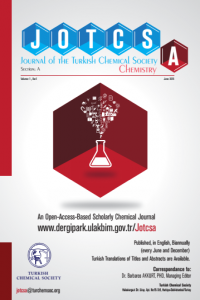Abstract
Polyurethanes are versatile polymeric materials and are usually synthesised by isocyanate reactions with polyols. Due to the variety of isocyanates and polyols, particularly polyols, polyurethanes can be easily tailored for wide applications, such as rigid and flexible foams, coatings, adhesives, and elastomers. Considerable efforts have been recently devoted to developing bio-based substitutes for petroleum-based polyuretahanes due to increasing concerns over the depletion of petroleum resources, environment, and sustainability. Polyester polyols based on aliphatic and aromatic dicarboxylic acids are one of the most important materials in polymer technologies. Large volume of plants oils are used as renewable resources to produce various chemicals which are industrially important to make soaps, cosmetic products, surfactants, lubricants, diluents, plasticizers, inks, agrochemicals, composite materials, food industry. This study introduces synthesis and properties of bio-based polyols from different renewable feedstocks including vegetable oils and derivatives. A comparison of bio-based polyol properties with their petroleum-based analogues were investigated.
References
- References
- Ionescu, M. (2007). Chemistry and technology of polyols for polyurethanes. . Polymer International (Vol. 56). doi:10.1002/pi.2159
- Noreen, A., Zia, K. M., Zuber, M., & Tabasum, S. (2016). Progress in Organic Coatings Bio-based polyurethane : An efficient and environment friendly coating systems : A review, 91, 25–32.
- Campanella, A., Rustoy, E., Baldessari, A., & Baltan??s, M. A. (2010). Lubricants from chemically modified vegetable oils. Bioresource Technology, 101(1), 245–254. doi:10.1016/j.biortech.2009.08.035
- Alagi, P., & Hong, S. C. (2015). Vegetable oil-based polyols for sustainable polyurethanes. Macromolecular Research, pp. 1–8. doi:10.1007/s13233-015-3154-6
- Desroches, M., Escouvois, M., Auvergne, R., Caillol, S., & Boutevin, B. (2012). From Vegetable Oils to Polyurethanes: Synthetic Routes to Polyols and Main Industrial Products. Polymer Reviews, 52(1), 38–79. doi:10.1080/15583724.2011.640443
- Pfister, D. P., Xia, Y., & Larock, R. C. (2011). Recent advances in vegetable oil-based polyurethanes. ChemSusChem. doi:10.1002/cssc.201000378
- Petrovic, Z. (2008). Polyurethanes from Vegetable Oils. Polymer Reviews, 48(1), 109–155. doi:10.1080/15583720701834224
- Polyols, V. O. (2015). Feature Article, 23(12), 1079–1086. doi:10.1007/s13233-015-3154-6
- Kadkin, O., Osajda, K., Kaszynski, P., & Barber, T. A. (2003). Polyester Polyols : Synthesis and Characterization of Diethylene Glycol Terephthalate Oligomers, 41, 1114–1123.
- Sonnenschein, M. F. (2014). Polyurethanes: Science, Technology, Markets, and Trends. Polyurethanes: Science, Technology, Markets, and Trends. doi:10.1002/9781118901274
- Septevani, A. A., Evans, D. A. C., Chaleat, C., Martin, D. J., & Annamalai, P. K. (2015). A systematic study substituting polyether polyol with palm kernel oil based polyester polyol in rigid polyurethane foam. Industrial Crops and Products, 66, 16–26. doi:10.1016/j.indcrop.2014.11.053
- Ang, K. P., Lee, C. S., Cheng, S. F., & Chuah, C. H. (2014). Synthesis of palm oil-based polyester polyol for polyurethane adhesive production. Journal of Applied Polymer Science, 131(6). doi:10.1002/app.39967
Abstract
References
- References
- Ionescu, M. (2007). Chemistry and technology of polyols for polyurethanes. . Polymer International (Vol. 56). doi:10.1002/pi.2159
- Noreen, A., Zia, K. M., Zuber, M., & Tabasum, S. (2016). Progress in Organic Coatings Bio-based polyurethane : An efficient and environment friendly coating systems : A review, 91, 25–32.
- Campanella, A., Rustoy, E., Baldessari, A., & Baltan??s, M. A. (2010). Lubricants from chemically modified vegetable oils. Bioresource Technology, 101(1), 245–254. doi:10.1016/j.biortech.2009.08.035
- Alagi, P., & Hong, S. C. (2015). Vegetable oil-based polyols for sustainable polyurethanes. Macromolecular Research, pp. 1–8. doi:10.1007/s13233-015-3154-6
- Desroches, M., Escouvois, M., Auvergne, R., Caillol, S., & Boutevin, B. (2012). From Vegetable Oils to Polyurethanes: Synthetic Routes to Polyols and Main Industrial Products. Polymer Reviews, 52(1), 38–79. doi:10.1080/15583724.2011.640443
- Pfister, D. P., Xia, Y., & Larock, R. C. (2011). Recent advances in vegetable oil-based polyurethanes. ChemSusChem. doi:10.1002/cssc.201000378
- Petrovic, Z. (2008). Polyurethanes from Vegetable Oils. Polymer Reviews, 48(1), 109–155. doi:10.1080/15583720701834224
- Polyols, V. O. (2015). Feature Article, 23(12), 1079–1086. doi:10.1007/s13233-015-3154-6
- Kadkin, O., Osajda, K., Kaszynski, P., & Barber, T. A. (2003). Polyester Polyols : Synthesis and Characterization of Diethylene Glycol Terephthalate Oligomers, 41, 1114–1123.
- Sonnenschein, M. F. (2014). Polyurethanes: Science, Technology, Markets, and Trends. Polyurethanes: Science, Technology, Markets, and Trends. doi:10.1002/9781118901274
- Septevani, A. A., Evans, D. A. C., Chaleat, C., Martin, D. J., & Annamalai, P. K. (2015). A systematic study substituting polyether polyol with palm kernel oil based polyester polyol in rigid polyurethane foam. Industrial Crops and Products, 66, 16–26. doi:10.1016/j.indcrop.2014.11.053
- Ang, K. P., Lee, C. S., Cheng, S. F., & Chuah, C. H. (2014). Synthesis of palm oil-based polyester polyol for polyurethane adhesive production. Journal of Applied Polymer Science, 131(6). doi:10.1002/app.39967
Details
| Journal Section | Articles |
|---|---|
| Authors | |
| Publication Date | January 8, 2017 |
| Submission Date | July 1, 2016 |
| Published in Issue | Year 2016 Volume: 3 Issue: 3 |


